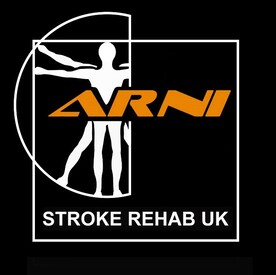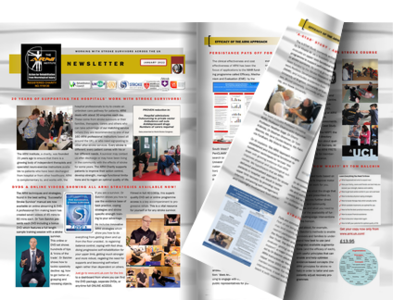Dr Tom's son instructing on the mat at ARNI Training Day for his very first time on Saturday, doing 'stick end touches' to challenge Sharon's reach, ranges of motion, accuracy & proprioception of her paretic arm as much as possible!
... See MoreSee Less
Whether you are starting with no movement or partial movement, neuroplasticity is always the key; and you can encourage neuroplasticity by performing high repetition of your stroke exercises.
If you need some help then call us on 0203 053 0111 or email support@arni.uk.com to find out if there's a trainer near you.
www.arni.uk.#ARNIstrokerehabre#arnistrokecharitya#Stroket#strokesurvivorsiv#neuroplasticityi#neurorehabrehab
... See MoreSee Less
📣 Calling All Stroke Survivors on this ARNI Facebook page - PLEASE HELP TWO YOUNG OT'S IN STROKE!🌿🚶♀️🪴 Have you had a stroke and enjoy getting involved with nature? Whether you love gardening, going for outdoor walks, training in nature, or helping with conservation projects, your experiences could shape the future of stroke rehabilitation!
Izzy and Rocksy, two Occupational Therapy students from the University of Southampton and friends of ARNI Stroke Rehab UK, are doing an important study and would love to hear from as many of you as possible! 🙏 They want to understand how people with neurological conditions experience and engage with nature-based activities.
Your unique insights can DEFINITELY help them create better, more accessible nature-based programmes for all stroke survivors. Getting involved means participating in a quick, computer-based interview (so you can do it from the comfort of your own home!) that will help advance research in this vital area.
Please consider thanking ARNI for the content on stroke that you read, and sparing some time to help these dedicated students - they are students of long-time ARNI Supporter at Southampton Uni, Dr Leisle Ezekiel, a senior OT and lecturer in fatigue research!
To take part or find out more, please contact them right now, directly via email:
📧 Izzy: im2g23@soton.ac.uk
📧 Rocksy: ra11g23@soton.ac.uk
Find out more on arni.uk.com/getting-involved-with-nature-for-a-better-stroke-recovery/
Let's work together to show how powerful nature can be in our recovery journey! 🌳💖
Please share this post!
www.ar#ARNIstrokerehabt#strokesurvivork#naturerecoveryr#getinvolvede#researchstudye#OccupationalTherapyna#neurorehabN#HealthResearchthResearch
... See MoreSee Less
⚠️ URGENT HEALTH WARNING: The Hidden Dangers of Excessive Energy Drink Consumption ⚠️This is a wake-up call! 🤯 A case study just published in the BMJ Case Reports details the shocking story of a seemingly fit and healthy man in his 50s who suffered a severe stroke, all because of his daily habit of downing EIGHT CANS of energy drinks.
He was an avid runner with no other vices (no smoking or drugs), yet doctors found his blood pressure at a staggering and life-threatening 254/150 mmHg upon hospital admission... far above the normal range of 120/80 mmHg. This incident shows why high blood pressure is often called the 'silent killer'.
Each can contained around 160mg of caffeine, pushing his total daily intake to over 1,200mg, more than three times the recommended daily maximum of 400mg for a healthy adult!
Once he completely stopped drinking the energy drinks, his blood pressure normalised within a week, but the damage was already done. Eight years later, he still lives with permanent numbness and weakness on his left side.
Doctors are now urging for tighter regulation on these potent drinks and advising healthcare professionals to specifically ask patients presenting with unexplained high blood pressure about their energy drink habits.
ARNI Stroke Rehab UK Charity asks you today to please SHARE THIS POST to warn others who may not know of the serious cardiovascular risks associated with excessive consumption of these highly caffeinated beverages... 💔🧠
www.ar#ARNIstrokerehabt#EnergyDrinkDangersi#StrokeRiskS#publichealthwarningl#bloodpressureo#caffeineoverdosen#HealthAwarenessh#silentkillerl#bmjcasereportsa#staysafe #StaySafe
... See MoreSee Less
Did you know there's compelling evidence supporting the unique structure of ARNI stroke rehabilitation where survivors train one-to-one within a group class environment?
This powerful approach merges strong quantitative data (what we can measure in numbers) with rich qualitative data (survivors' lived experiences), creating an optimal recovery setting. Quantitatively, studies show that intense, individualised task-specific practice - the hallmark of ARNI's functional approach - leads to significant measurable improvements in strength, balance, and walking speed. The focus remains strictly on the individual's needs, maximising the repetition crucial for driving neuroplasticity.
Qualitatively, survivors consistently report profound benefits from the social dynamics and peer support that naturally occur in a group setting. They feel less isolated, more motivated by observing others, and empowered by a community of shared experience.
This dual benefit provides both the intense focus required for physical gains and the vital social and psychological scaffolding that quantitative data alone often overlooks, making ARNI stroke rehab intervention a truly holistic and highly effective path to recovery. 🙏🌟
To find out more about the innovative & evidence-based ARNI approach - and connect with a local instructor, just visit the ARNI website:
www.arni.uk.com
#StrokeRecovery #ARNIStrokeRehab #Neuroplasticity #StrokeSurvivor #PhysicalTherapy #RehabWarrior #GetStronger #BrainHealth #Hope
... See MoreSee Less
Getting Involved with Nature for a Better Stroke Recovery -
... See MoreSee Less
Active range of motion is when a person can move a body part on their own without assistance.
Passive range of motion refers to an external force moving a body part rather than it moving on its own. Examples would be a stroke survivor taking his/her strong arm and moving the weak or paralyzed arm. It is important in order to maintain flexible joints and prevent joint contracture. (Joint contracture occurs when there are structural changes to the soft tissue such as tightening or shortening of muscles and tendons that restrict movement).
If someone can only partially lift their arm and someone assists them in lifting the arm further (or they use their strong arm to assist) this is called active assistive range of motion and is helpful in strengthening a limb that does not yet have full range of motion.
www.arni.uk.com
#neuroplasticity #ARNIstrokerehab #neurorehab #strokeexercise #strokerehab #strokesurvivorscan #neurorehabilitation #strokerehabilitation #ARNIstrokerehab
... See MoreSee Less
Whether you are starting with no movement or partial movement, neuroplasticity is always the key; and you can encourage neuroplasticity by performing high repetition of your stroke exercises.
If you need some help then call us on 0203 053 0111 or email support@arni.uk.com to find out if there's a trainer near you who can help you.
www.arni.uk.#ARNIstrokerehabre#arnistrokecharitya#Stroket#strokesurvivorsiv#neuroplasticityi#neurorehabrehab
... See MoreSee Less
ARNI course professional, Fiona Morrison, just asked me: Hi Tom, one question I didn’t get a chance to ask you about, what did you mean by 'spasticity suffers through velocity' in your talk?
We bet that some of YOU know the clinical answer... so for all our fellow rehab professionals and curious minds, let's break down why spasticity is fundamentally velocity-dependent in technical terms. It all basically comes down to the neurophysiology of the stretch reflex arc following an upper motor neuron (UMN) lesion.
The critical factor is the hyperexcitability of the monosynaptic stretch reflex. After a UMN injury (like a stroke), we lose essential descending inhibitory inputs from the brain and brainstem that normally modulate the alpha motor neurons in the spinal cord. This creates a state of disinhibition.
The muscle spindles contain primary Ia afferent fibres which are highly sensitive to the rate of change in muscle length (velocity). When a spastic muscle is stretched passively, the faster that stretch is applied, the more robustly these Ia afferents fire.
Because the reflex arc is now disinhibited, this heightened afferent signal leads to an exaggerated efferent response from the alpha motor neurons, causing a brisk, involuntary contraction and increased resistance.
So, essentially, speed is the key trigger! The quicker the movement, the stronger the sensory feedback that bypasses normal modulation, resulting in that characteristic resistance we measure clinically, using scales like the Modified Ashworth Scale (MAS) and the Tardieu Scale (evaluating stretch reflex at different speeds).
For more about spasticity, please see this post on the ARNI site from 2019: arni.uk.com/spasticity-after-stroke-will-my-hand-ever-get-better/
www.arni.uk.com
#ARNIstrokerehab #NeuroRehab #Spasticity #Neuroscience #Physiotherapy #StrokeRecovery #ScienceExplained #pt
... See MoreSee Less


